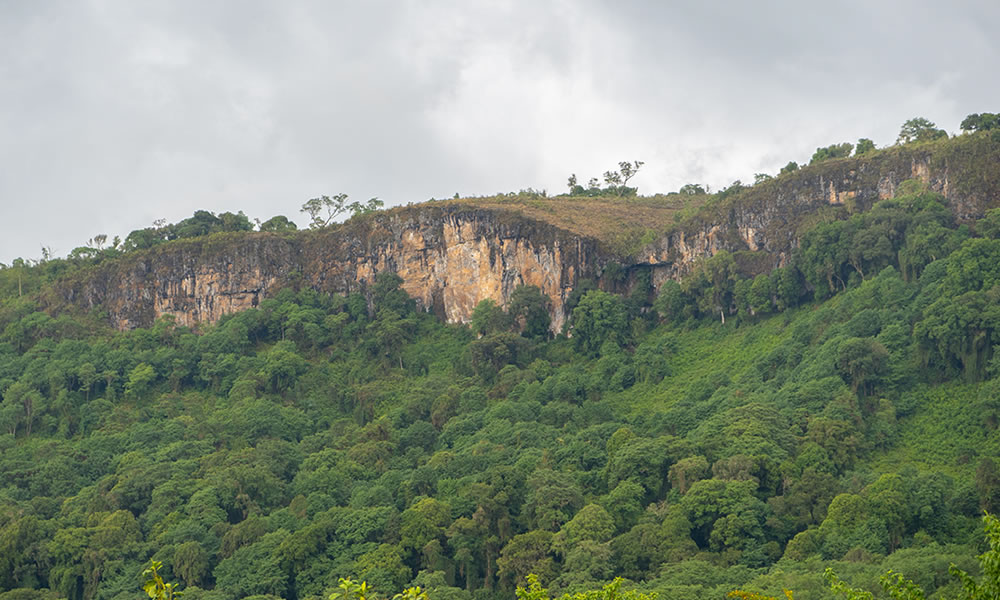Mount Elgon National Park is situated on the slopes of Mount Elgon in the eastern part of Uganda in the Kapchorwa district that borders Kenya and Uganda. Mount Elgon has the largest surface area of any extinct volcano in the world, spanning approximately 1250 km, and a caldera that covers a total land area of 1145 sq km. At 4321 metres above sea level, it is the fourth highest mountain in Eastern Africa, with Wagagai Peak, Uganda’s second highest peak, at 4321 metres. Mount Elgon National Park is the second closest park to Kampala, located roughly 235 kilometres away and taking about 4 hours to get by car. The last known eruption of the now-extinct volcano Mountain Elgon occurred more than 24 million years ago.

Activities in Mount Elgon National Park
Climbing Mount Elgon
There are two primary trailheads on Mount Elgon that lead to Wagagai: The most direct path to the summits is the Salsa Trail, which begins at the Buddukiro trailhead and is the most easily accessible from Mbale. The largest section of bamboo forest in the Park is traversed by it. On the first day, there is a steep and difficult ascent of more than 1600 metres. Pisa Trail (trailhead near Kapkwata). You can explore a sizable Podocarpus forest along this path, which is a great spot to see wildlife. It takes four to five days to do the entire trekking circuit to the summits. It is recommended that travellers discuss their options with an information clerk at the visitor centres located in Male, Budadiri, or Kapkwata. When you climb Mount Elgon, you will have the chance to witness the variety of flora as well as a wide range of wild animals, including buffalo and elephants, as well as several species of monkeys, such as red-tailed, black-and-white, blue, and so forth. While trekking to the top of the mountain, you can witness more than half of Uganda’s butter flies on Mount Elgon.
Nature Walk
The Elgon National Park’s Nature Walk takes you on many paths, including the Forest Exploration Center’s three day walks that span between 3 and 7 kilometres. Here, you may view a variety of flora species, including fauna, bird species, and butter flies. The road that leads to Sipi Falls, the Bagisu and Sebei culture communities, and other places is frequented by wild animals like buffalo and elephants who come for the natural salt found on the cave’s walls.
Sipi Falls
Because of the stunning setting that Mount Elgon National Park offers, visitors find the Sipi Falls to be a terrific addition. This has drawn a variety of bird species, including both forest and aquatic birds. The three waterfalls that make up the Sipi falls, each with a distinct height of flow, provide an exhilarating experience. This location has a cold climate due to its hilly terrain, and occasionally people hike in the rain, which makes the experience challenging but unique. Overall, this area is meant to be used for unwinding and resting after a strenuous day of hiking.
Bird Watching
With over 312 bird species, Mountain Elgon National Park is the best park in Eastern Uganda for birdwatching. Notable species include Chubb’s Cisticola, African Goshawk, White-chinned Prinia, African Blue Fly-catchers, Mackinon’s Fiscal, Doherty’s and Luhders’s Bush-Shrikes, and Baglafecht Weaver, which can be seen in the dense scrub and forest near the camp.
Community Walks
The community walk around Mount Elgon offers you the chance to engage with this Budadiri-based group that is very important to tourists, including the Bagisu and Sebei tribes. The community offers a variety of services and amenities to visitors, including guided coffee tours with a community nature walk, lodging, cultural dances, and car rentals. Visitors learn more about the region’s cultural traditions through the activity, including those related to food, dances, and values. Visitors will get the opportunity to see the well-known Arabica coffee processing facilities during the community walk, which is a terrific way to help the local farmers.
Best time to visit Mountain Elgon National Park
Although tourists visit Mountain Elgon National Park year-round, hiking is best done in July–August and December–February. Since these are typically Uganda’s dry months, hiking and mountain climbing are more accessible.
